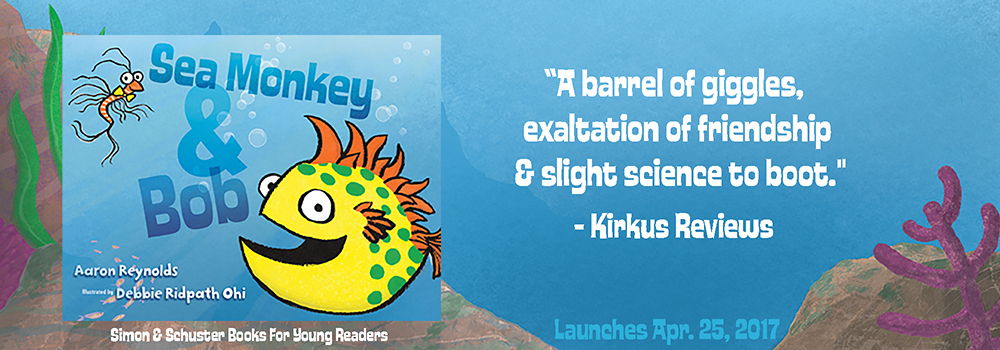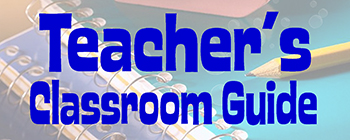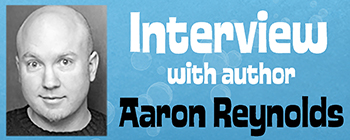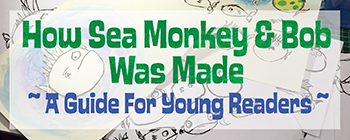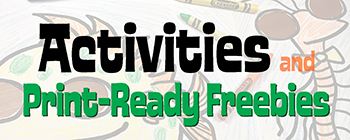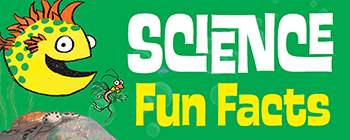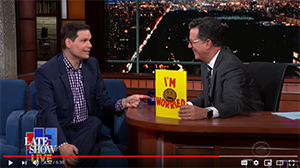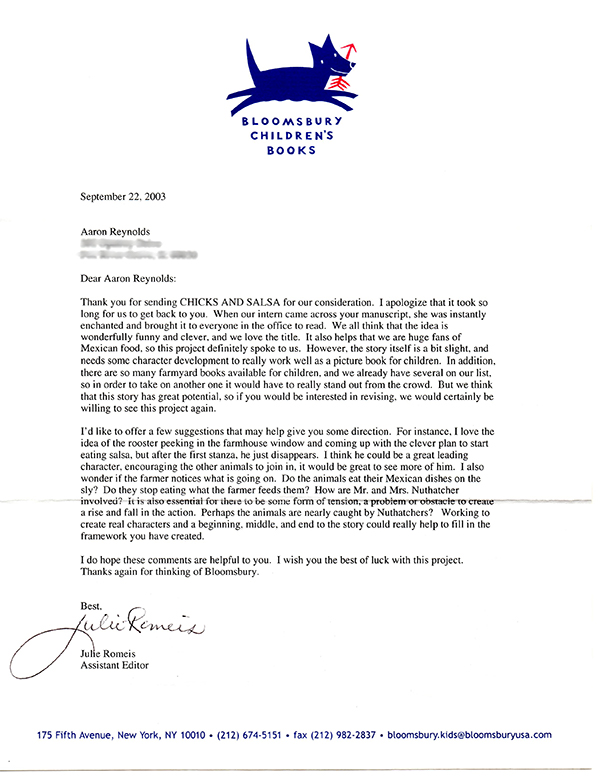Back to main Sea Monkey & Bob page
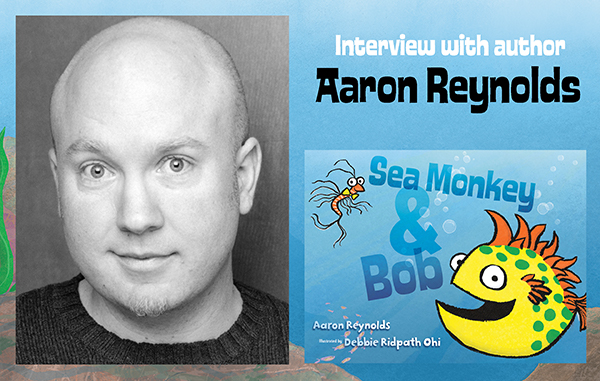
INTERVIEW WITH AARON REYNOLDS
Author of SEA MONKEY & BOB
Aaron Reynolds is a New York Times bestselling author whose children's books include Creepy Carrots!, Carnivores, President Squid, Nerdy Birdy, and the Joey Fly, Private Eye graphic novel series. Aaron regularly makes time to visit schools where his hilarious hands-on presentations keep kids spellbound. You can find out more about Aaron and his work at Aaron-Reynolds.com, Twitter and Instagram.
FOR YOUNG READERS:
Q. How did you get the idea for writing SEA MONKEY & BOB?
I have no idea where I get any of my ideas! My mom always said I was immature, and I guess it comes in handy now, because weird ideas just pop into my mind. If I'm remembering right, the original idea was a story called Holey Mackerel! about a Mackerel who was scared he was sinking. Here's a picture from my writing journal of that:
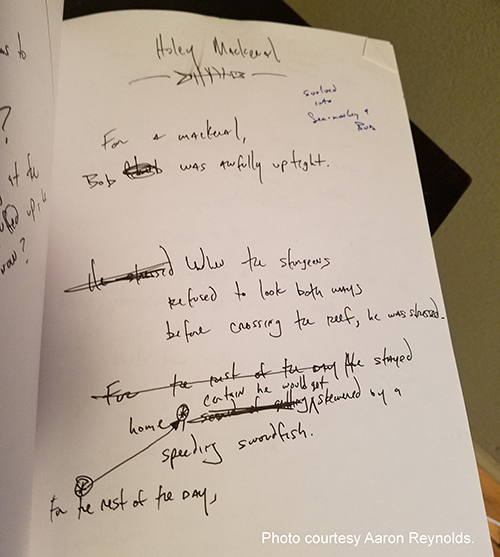
That story didn't quite work (as many often don't), but it evolved to become Sea Monkey and Bob.
Q. Have you ever raised Sea Monkeys?
Nope, I never had Sea Monkeys, but I always wanted to send away for them from the ad in my comic books. But I once sent away for X-ray specs! They were...disappointing.
Q. What was the process like after Simon & Schuster said they wanted to publish your story?
They said they wanted to publish it and I cheered! Then my editor, a guy named Justin Chanda, gave me some suggestions for ways to make my story better. I made all of his changes and then some! Once the story was just right, it got handed off to Debbie so that she could create the art. I don't hear much during this time. Sometimes it takes a couple years before I hear anything more. But once the art starts to get closer to finished, Justin shows it to me. Before long, my words get put together with Debbie's art and we start to have something that resembles a book!
Q. What is your office like?
Small but mighty! Here's a pic of my desk:

Q. Do you like swimming?
I like sitting near water with a fruity drink in my hand. Does that count?
Q. Have you ever had pet fish?
Yes, many. I'm sad to report that none of them ever made it past the age of two weeks.
 My cat, Mousie, who is my writing buddy and is always in my writing office with me.
My cat, Mousie, who is my writing buddy and is always in my writing office with me.
Q. Do you identify more with Sea Monkey or Bob?
Bob. I'm not a natural worrier. But when other people get worried about stuff, I sometimes find myself wondering... "Maybe I SHOULD be worried about that after all!"
Q. Did you write a lot when you were a little kid?
Nope. But I liked to draw and had lots of ideas. I once won a poster contest about conserving electricity. It featured a dragon heating his house by breathing fire into it. In retrospect, it's not the best idea to tell kids they can save energy by setting fire to their house. What were those judges thinking???
Q. What advice do you have for young writers?
Two tips for getting good at writing:
1. Read like crazy! Nothing fills you up with ideas like reading books. Plus, along the way, you learn what good writing looks like, the more you read it.
2. Write like crazy! You get good by doing it! Whether you like to journal, make your own comics, write stories...do it a lot! You'll find you are getting better and better.
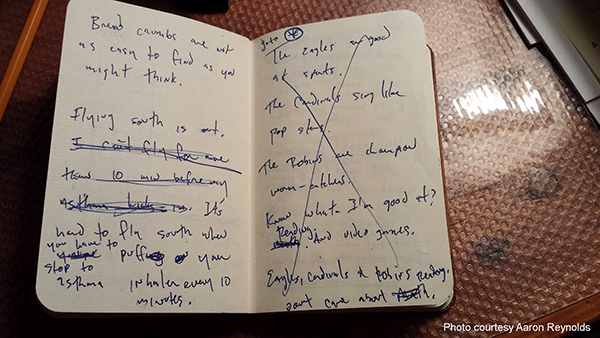
FOR GROWN-UPS:
Q. What do you enjoy most about doing author visits?
I LOVE creating unique and fun presentations that will inspire kids and get them excited about books. I want kids to see that books aren't just this quiet little activity. There are lots of rowdy kids out there who think reading is not for them. Reading is rowdy, and exciting, and inspiring, and passionate! I want them to see how much books inspire my crazy, fun, madcap life.

Q. How have you found that your author visits help students?
I get e-mails and letters constantly from teachers and librarians who say that Jimmy or Mallory wouldn't touch books before my visit, but now they won't put them down. Great author visits help turns non-readers into readers, and readers into passionate readers. They also help kids see that authors are real people. It demystifies the idea of being an author. Jimmy and Mallory see that, if a goofball like Aaron Reynolds can become an author, maybe they could too. That's powerful.

Q. How do you find the right balance between creating new books and talking about your books? Any time management tips?
I do a lot of school visits. So I've found the best way to work is to break my life up into seasons. I don't write every day. I spend about six months out of the year traveling around the country doing author presentations at schools. During these six months, I may not write at all, but I'm usually doing revisions on something. Then, the other six months out of the year, I don't travel or do speaking engagements at all. During those months, I write every day.
It's important to remember that there's not only one way to write. You have to find the rhythm that works best for you. But writing consistently is key. For me, that's a seasonal thing.
Q. I read that it took you over 5 years and over 400 rejection letters before you got your first sale. Could you tell us more about your path to publication?
Long and hard. A lot of people think writing kids' books is easy and getting published is super quick. Nope. I got 390 rejections over the course of five years. But I kept at it. I found myself getting better. For about three years, I got nothing but form letter rejections. Then, I started to get form letters, but with a little hand-written note of encouragement from the editor at the bottom: "Hey, Aaron. This is funny. It's not right for us, but you have talent. Keep going!" After awhile, I started to get editors who rejected my manuscript, but wanted to see more from me. I attended SCBWI events and conferences. I learned and grew. Even my first acceptance was really a rejection. CHICKS AND SALSA was rejected by Bloomsbury, but it was a great rejection because they gave me lots of notes and wanted to see it again. Here's that original rejection letter:
I rewrote it and sent it back to them. Twelve months later, I got my first acceptance.
Malcolm Gladwell talks about putting in your 10,000 hours. He says that the difference between people who want to become something and the people who have become it and are mastering it is 10,000 hours. He is so right. There is no shortcut. Yes, occasionally we hear the story of the writer who sold their first book to the first publisher they sent it to, and it became a NYT Bestseller. But in reality, that rarely happens. You have to put in your 10,000 hours. And you have to want it badly enough to be willing to slog through those 10,000 hours to get there.
Q. What’s the biggest mistake that beginning writers tend to make?
Not getting intimately familiar with what is being published. And not necessarily the best-sellers, because some of those are written by celebrities or known people and that's the major reason they got published, so they're not good examples. I'm talking about regularly sitting on the floor of a bookstore reading a mountain of freshly released picture books. Knowing the market intimately helps you see the type of stuff that is being bought by publishers.
Also, writing it rhyme. While there are exceptions, writing in rhyme is a rookie mistake. Try to avoid it.
Also writing about your dog. Please don't write about your dog.
Q. What is your approach for social media?
In truth, I don't love social media. If you follow me or friend me, you won't see lots of pictures of my family, my personal life, or what I ate for lunch. I'm a pretty private person and don't really love broadcasting the details of my life. Having said that, social media is a great way to let people know about new books, or where you'll be doing a signing. So I try to consistently put stuff out there that I hope people will care about as relates to my books and appearances. I have a hard time keeping up with multiple social medias, so I mostly use Instagram to post to FB, Twitter, and Tumblr.
Q. Your picture book stories are SO original and fresh and funny. What is your writing process?
Thank you! But, gosh, this is a tough question. I guess it goes like this:
1. I get the nugget of an idea. Not fully formed, just a nugget.
2. I write it down and either pin it to my board by my desk or put it under something I have in my office called my "Idea Rock" (it's just a big rock with several hundred scraps of paper under it...all ideas that I got and may or may not ever do anything with.)

3. Then I try to forget about it. I go on with life. I do school visits.
4. Since I've written them down, most of the ideas leave my head and never come back. But some won't go away, even though I've written them down.
5. During the six months of the year that I do school visits and don't write, I stew on these couple ideas. The nugget starts to take shape.
6. When my six months of the year that I do school visits ends, I usually have two or three ideas that I'm eager to write about.
7. During the next six months, I sit down every day and write. I try to figure out the stories that have started to take shape. I don't usually outline more than a rough rundown of the story. Most of the story comes together while I'm sitting at the computer or in front of the paper.
8. I write, cross a lot out, write more, re-write, etc....until I have something I'm happy with.
9. I print it, put it away, and let it sit for a month or two. During that time, I move on to the next story. I don't look at it.
10. After a couple months, I pull it out. I now have fresh eyes and usually see things that don't work as well as I thought I did. Changes are easy to make now, because they're not fresh and as precious to me as they were when I first wrote them. I make changes that will improve the story.
11. Only then, do I send it to my agent to be submitted to publishers.
I guess that's my process. And many new writers are surprised to hear me say that the most important part of that process is TIME. Time to put the idea away and let it stew. Time to shelve the finished story so I can come back to it fresh. That time really makes a difference.
